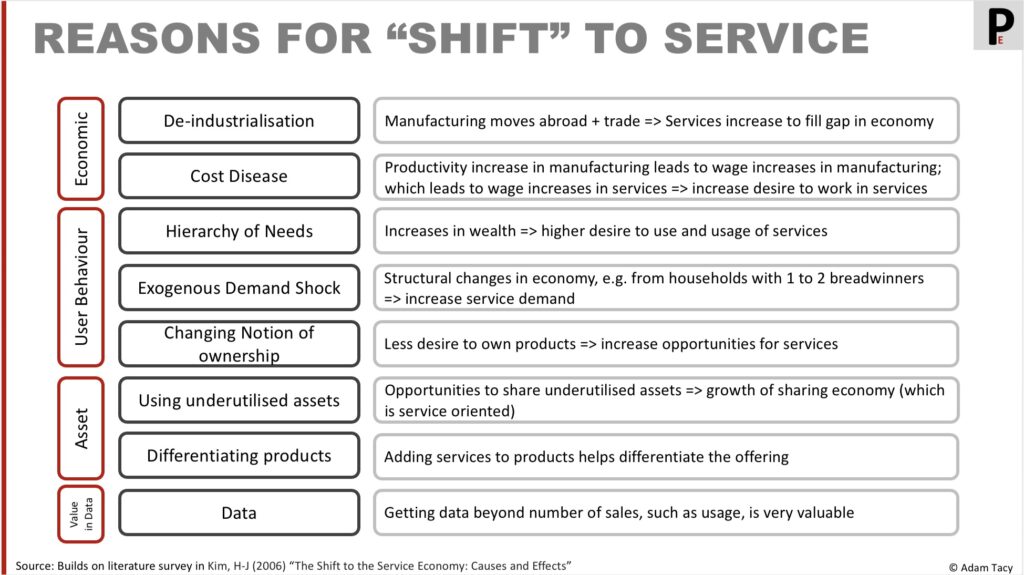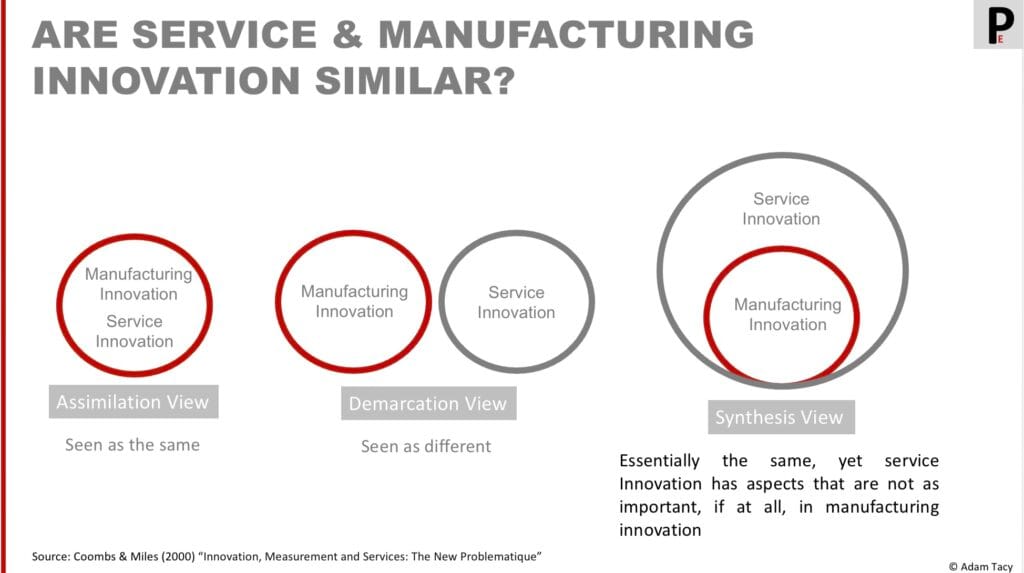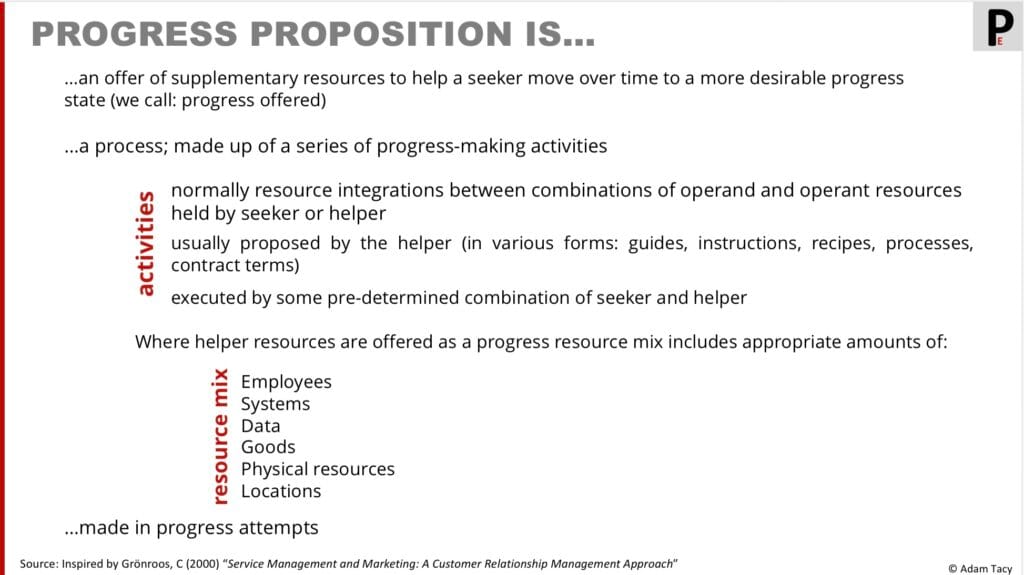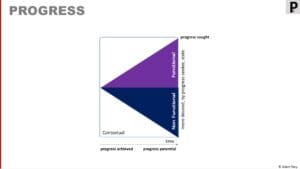What we’re thinking
We can, and must, do better than our prevailing definitions of innovation.
Let’s ditch the vague definitions we typically lean on (we’re even looking at you ISO 56000!). They revolve around adding/creating value…and value is something we know is poorly defined, hard to understand, and address. Our traditional definitions often lead us to the innovation problem and tempt us into innovation theatre.
Instead, we’ll harness the progress economy insight that value emerges from progress. So to increase value, we really need to improve the progress a seeker can make to their individual progress sought. More specifically:
innovation: creating and executing new – to the individual, firm, market, industry, world – progress proposition(s) that offer some combination of:
- improving how to make existing progress
- increasing progress that could be made (getting a seeker closer to their individual progress sought)
- reducing one or more of the six progress hurdles*
- increasing (amounts and/or frequency) seeker’s judgements of recognised value during the journey
whilst maintaining, or improving, the survivability of the actor** undertaking it.
* lack of resource, adoptability, resistance, lack of confidence, misalignment on continuum, and equitable exchange
** seeker / helper (individual, organisation, network, ecosystem, service system)
And the progress economy reveals the tools to do this – a view of progress – functional, non-functional and contextual – that allows to reason about “better”; an evolved view of value (emerging from progress; needing to be recognised by seeker; and a potential for destruction); progress propositions; interchangeable resources – carriers of capability – in progress resource mixes; progress-making activities; enabling-relieving continuum; progress hurdles; and more…
Now we can innovate with focus, reasoning and systematically.
Editing below here
[to rewrite referencing the more formal way of describing value/progress introduced in value-through-progress ]
”Innovate or die”, right? Traditional thinking has us believe that by failing to innovate our products become less valuable and so our firm will die.
The progress economy tells us that progress sought constantly evolves and seekers constantly experience new ways of making progress.
Ever wonder why, according to McKinsey, 94% of executives are dissatisfied with their organisations’ innovation efforts?
There are several reasons for this. Not least, I would argue, are the definitions of innovation that we have and use. Most are vague and inactionable. As well as being rooted in the old way of understanding value.
In the progress economy, we have a different definition. It flows directly from our understanding of progress and progress propositions. And is focused on the outcome while eliminating short-sightedness. It is:
Innovation: creating and executing new – to the firm, market/industry or world – progress propositions that offer some combination of:
i) helping to make progress better
ii) helping to make better progress
iii) lowering any of the six hurdles to engaging with a progress proposition
whilst maintaining, or improving, the survivability of the progress helper
And it’s rooted in the belief that:
- progress comprises functional and non-functional elements and informed by context
- entities – progress seekers – are trying to make progress with all aspects of their lives
- other entities – progress helpers – form to offer help with specific progress in the form of progress propositions (a service mix plus proposed activities)
- progress seekers go through a decision process to determine if they will start, and continue, engaging with a particular progress proposition
Innovation then must, and can only, be about these 3 cases. Firstly, being able to offer to help make better (wider, further, additional…) progress than currently possible. Or, secondly, by helping make existing progress better. And thirdly, through lowering one or more of the 6 hurdles in the engagement decision process.
And why do we innovate? Well, seekers’ progress sought constantly evolves, our range of items we can put in the service mix constantly evolves, and we have competitors.
This definition of innovation is part of the foundation layer of the progress economy tooling.
how things look today
Back in 2013, Edison, bin Ali and Torkar (2013) studied innovation in the software industry and found 41 (!) separate definitions of innovation. Where typical definition includes three aspects. Innovation:
- is a process and an output
- that creates something new/novel (where that something could be products/ goods/ services/ processes)
- that has value
Typically value focusses on value embedded by the maker. Over at Idea2Value.com, they summarise 15 innovation experts’ definitions, finding only 40% noted value to customer.
Even the OECD’s definition focusses only on the supplier/creator.
An innovation is a new product or process (or combination thereof) that differs significantly from the unit’s previous products or processes and that has been made available to potential users (product) or brought into use by the unit (process)
The Oslo Manual (OECD, 2020)
ISO 50009 – Innovation Management – Fundamentals and Vocabulary
Now if we look at the International Standards Organisation definition from 2020, they define innovation as:
3.1.1 Innovation: new or changed entity1, realizing or redistributing value2
1anything perceivable or conceivable. Example: product, service, process, model, method, or combination thereof.
2gains from satisfying needs and expectations, in relation to the resources used. Example: revenues, savings, productivity, sustainability, satisfaction, empowerment, experience, engagement, trust.
note: innovation is an outcome. If used referring to activities and processes, some form of qualifier is required, e.g. ”innovation activities”
note: novelty is relative to, and determined by the perception of the organisations and interested parties
ISO 56000 (2020) – Innovation Management – Fundamentals and Vocabulary
So we could perhaps say innovation is “a new or changed service mix and/or series of proposed activities, realising gains in progress in relation to resources used”. But ISO then go on to clarify that:
value can be created, realized, acquired, redistributed, shared, lost, or destroyed…value is relative to, and determined by the perception of the organisations and interested parties
Sadly, we’re back to the old school value-in-exchange thinking.
invention vs innovation
Also missing from many definitions is the difference between inventing and innovation. That’s to say coming up with ideas (invention) and implementing them (innovation). Back to Idea2Value.com, they found only 60% of definitions they looked at include “having or executing the idea”.
roots are in manufacturing
Another finding worth considering is from Gallouj and Weinstein’s “Innovation in Services“. And it is that we base most of today’s innovation theory on technological innovation from within manufacturing companies. Which is exactly what we see in the 2020 ISO definitions around value.
The problem with this is it risks driving us to be short sighted.
Innovation is like marketing and sales, only harder. Share on XWhen we think in terms of manufacturing, we immediately think in terms of goods and their features. Often in a manner Kottler shows us in his ”Principles of Marketing”.

And so we embark on feature innovation. Convincing ourselves that user needs are found behind them. We’re all familiar with the ”add another razor blade” syndrome. Where shaving technology innovation over the last few years has really been constrained to adding yet another razor blade to the razor head.
Of course we can be disciplined and not let feature innovation lead us. But does innovation in progress propositions (service) work the same as innovation in manufacturing? And does it matter?
service vs manufacturing innovation
From a traditional goods-dominant view of the world we can say that service is eating the world. And in Chesbrough’s “Open Innovation” he nicely captures the perceived shift to a service economy. From predominantly agricultural, through goods and towards today’s predominantly service economy. Which I recreate in the left hand of the slide image below.


Whereas our underlying service-dominant logic informs us that everything is, has, and will be a service. So the shift we see is actually in skills and competence sought. You can compare both these views above.
These shifts can also be seen through the lens of the service-service continuum.

Where on the left we have enabling propositions. Which can be loosely seen as enabling self service. Through to relieving propositions on the right. Which is where the seeker hands all responsibility for progress to a helper.
But why do we see such a shift? the reasons for this shift in skills sought are numerous. I categorise them as: economic, user behaviour, asset and value in data.

These can be used as inspiration sources for innovation
Noting that these reasons are sources of innovation to move along the service-service mix from enabling towards more relieving propositions.
But, are there differences between manufacturing and service innovation? This is something Coombs & Miles take up in “Innovation, Measurement and Services: The New Problematique”. They offer three potential views: assimilation, demarcation and synthesis.
assimilation, demarcation or synthesis?
With Coombs & Miles introducing these three views, Witel et al (2016) provide a worth reading and comprehensive literature survey around them in “Defining Service Innovation: A review and Synthesis”.

In the progress economy, we see goods as one equal level component in the service mix. Therefore, we can’t say innovation is different between goods (manufacturing) and service. That leads us, by definition, to reject the demarcation view – where manufacturing and service innovation are seen as different.
That leaves the assimilation and synthesis views. Where the assimilation view tells us innovation is the same for service and manufacturing. However, that causes us a problem, since innovation in manufacturing is seen as driven by value-in-exchange – the basic belief in goods-dominant logic. See table 7 in Witel et al (2016).
And, value-in-exchange is opposite to our underlying service-dominant logic – where we see value-in-use. So the assimilation view can also not be the correct view.
Thus, the synthesis view is appropriate. That is to say:
innovation in the progress economy is essentially similar to, yet has aspects that are not as important, if at all, in manufacturing innovation.
With the caveat that service-dominant logic informs us that goods are transportation mechanisms for service. And therefore also follow value-in-use rather than value-in-exchange.
Why did we look at this? Isn’t it comforting that we can build on existing theories as long as we’re careful?
And actually, the progress economy’s repositioning of value, focus on progress, and the introduction of the service mix as well as the service-service continuum, handle those aspects in a seamless manner.
How, then, does the progress economy’s definition develop? Let’s follow along …
Innovation is creating and executing a progress proposition…
We start the progress economy’s definition clearly stating its about creating and executing a progress proposition. Immediately we are signalling this is more than just ideating.
And we’re creating and implementing a progress proposition. Which you’ll recall has the following definition.

So that means we are consistent with the progress economy view of value. That it can only be offered. We, as progress helpers, can not determine value and swap it in an exchange moment. It’s a common problem in innovation, the innovator feeling they determine value. Just watch your favourite episode of Dragon’s Den (or Shark Tank, or whatever it might be called in your location).
And it is here we get a next glimpse of an innovation zone. We can innovate the:
- progress being offered
- activities involved in the process of making progress
- service mix offered (for example swap employees out for a system)
- individual elements of the service mix (for example upgrade a system)
A little less directly obvious is that we can innovate our helper ecosystem (or start one if the helper is a single entity). Or we can slide ourselves along the service-service continuum. Which in turn will likely require us to adjust our service mix and series of activities.
Additionally, altering the service mix leads to the concept behind many of today’s innovative moves. Including:
- servitisation typically replaces goods in the mix with physical resources as well as adding systems
- digitisation typically lowers employees whilst increases system elements in the mix
- artificial intelligence and machine learning are “simply” systems encapsulating knowledge/skills that a seeker can integrate with
- digital twins requires adding systems to the mix and often employees to interpret the twin’s info for the seeker
- shifting online reduces physical resources (buildings etc) and increases systems in the mix
Let’s address what we mean by the word “new” in our definitions first sentence.
…that is new (but new to who?)
It’s easy to believe that a progress proposition is only innovative if it has never been seen before. But that’s too restrictive.
In the ISO definition of innovation they note that ”novelty is relative to, and determined by the perception of the organisations and interested parties”. However, I prefer the definition of Edison, bin Ali and Torkar’s (2013) in “Towards Innovation in the Software Industry”. They list four categories. An innovation can be new to the:
- firm (although let’s be more generic and say organisation)
- market
- industry
- world
I like this definition as it guides us to sources of innovation inspiration. What are other organisations, markets and industries doing that could be reused, to varying degrees, in yours? We can use den Hertog’s phrase of carrying innovation for this case (from “Knowledge-Intensive Business Services As Co-Producers Of Innovation“).
Benefits of carrying could include reusing skills and competence seekers have gained elsewhere. And progress seekers are an increasing driver here. More so they expect to do in your industry/market things they already can in others they interact with. QR codes are a good example of both situations. Being carried in the early days. And now being expected when seekers need to, for example, show a ticket of any kind.
New to the world innovations are as the phrase says, not been seen before.
…that offers to help make better progress
Let’s remind ourselves of the driver behind innovation. As Drucker says:
because the purpose of a business is to create a customer, the business enterprise has two – and only two – basic functions: marketing and innovation
p. drucker
Marketing is the function that helps us identify the progress sought by seekers. And the outcome of innovation is the progress offered, reflecting that marketing intelligence. We can nearly always help the seeker make better progress. Through new tools, technology, processes etc. And seekers’ progress sought continues to evolve. As they interact and progress through the world they experience new things, both in your market/industry and in others, and in their own circumstsnces. These all alter their needs and views.
Whether we help them make better functional and/or non-functional progress. Or we find a way to help them better in their context. This is how we help them make better progress. And better can be baselined against our current offering(s) or competitors.

It turns out there are four usable interpretations of better. We can offer to help the seeker make:
- Improving offer: more progress in the elements of known progress sought – we will find that we may not initially be able to help make full progress
- Over offer: more elements of progress than the identified progress sought – they may not be aware of it (yet)
- Under offer: less progress in elements of progress sought (by current market) – disrupting
- any combination of the above – creating new markets
Which we can visualise in the following gallery.
Let’s take each in turn, in no particular order.
Offering better progress sought
It’s probable that a helper’s current offer doesn’t offer to help with 100% of current progress sought. Perhaps it wasn’t possible to do so when the offer was created. Or, equally possible, the seeker has evolved their progress sought since the original offer was created.
This later can happen for various reasons. Seekers:
- learn when they are engaging with a proposition
- observe others using propositions
- are using other propositions in other markets and industries
- circumstances change
And the way to address this is to innovate to offer more of the progress being sought.

For example, the seeker could have ”quickly” as an element of non-functional progress sought. We could innovate to make our proposition quicker. They might have ”stay warm” as an element of functional progress. So we could innovate a way of staying warmer for longer. Or we might find a way that better fits the context of progress sought.
- Identify the latest view of progress sought
- Rank the elements in order of importance to progress seekers
- Ideate to identify ways of improving progress offered
- Rank ideas based on implementation complexity and budget for the specific progress helper
- Select ideas to execute and execute
Over offering
Another innovation approach is to result in over offering progress.

The intent being to address some progress sought that the seeker hasn’t identified themselves yet (or has but hasn’t put too great an emphasis on that).
Apple do this a lot with their hardware. In particular iPhones. Where they offer new functionality whose use becomes clearer once it is exploited.
Care needs to be taken that the over offer will be seen as helpful to seekers in the near future. Otherwise this may be seen as a hiring of hurdles that does not increase progress.
Under offering
Under offering progress may, at first, seem a strange strategy to capture growth.

But it typically results in simpler (more adoptable) and more affordable offerings -lowering two of the hurdles to engagement. And this approach does go by a name you may be more familiar with – disruptive innovation. Which was coined by Christensen n his “The Innovator’s Dilemma”.
It – disruptive innovation – is though an often misused term. As the Christensen Institute clarify:
Disruptive Innovations are NOT breakthrough technologies that make good products better; rather they are innovations that make products and services more accessible and affordable
Christensen Institute
Where a disruptive innovation initially targets non customers or low end customers. And then relentlessly move upwards, displacing existing helpers (disrupting them).
- Identify common progress sought in today’s market
- which of those progress elements can be reduced so that either
- the low end of the market still engage. That is, they still see an acceptable balance of potential progress and the hurdles of adoptability and service credits to engage?
- current non customers now decide to engage. That is to say they now see the hurdles of adoptability and service credits are reduced enough and potential progress is acceptable?
Combining
It is possible to innovate and provide a combination of the above 3 approaches. That is to say increase some elements of existing progress offered, whilst reducing some other elements of progress offered as well as over offering some others.
An interesting interpretation of combining approaches is the strategy canvas and the four action framework tools of Blue Ocean Strategy.
BLUE OCEAN STRATEGY is the simultaneous pursuit of differentiation and low cost to open up a new market space and create new demand. It is about creating and capturing uncontested market space, thereby making the competition irrelevant
BlueOceanStrategy.com
Blue Ocean’s buyer value elements can be interpreted as the progress economy’s elements of progress. And these can be used on the y-axis of the strategy canvas.

The idea then is to decide to raise, reduce, eliminate or create progress offered. Snap, at least in 2017, compared to Facebook and Instagram decided to:
- raise (improved progress) the first 4 elements in the above diagram – remove performance need , for example
- eliminate (reduce progress offered to no progress offered) element 6 – view past content
- reduce (under offered) elements 7 and 11 – ease of UI (which may seem strange given the hurdle of adoptability, but this is a rare case where poor adoptability by parents was seen by teenage seekers as a positive)
- create (over offer compared to current market) element 10 – keep parents out; see above.
The resultant progress offered should create a new uncontested market.
…and/or that offers to help make progress better
A sub of making better progress is making progress better. Here we are focussed on non-functional and contextual elements. Leaving functional progress as it is. It can relate to non-functional progress that is implicitly expressed – faster, simpler etc. Or explicit, such as enhanced green credentials. Don’t forget, more adoptabile, cheaper are addressed as hurdles in the progress economy.
Another alternative is to offer the same progress….only better. Although this may be a masking of the above options. Or it addresses lowering the hurdles below. Or increases the survivability of the helper. But lets consider what it means. Let’s say we’re currently offering to help a seeker with some specific functional and non-functional they are seeking, in the context they are in. Ideally we’re offering to help them make the full progress they are seeking. But sometimes there are limits.
We still need to innovate in this situation, even if we are not intending to deliberately increase the amount of progress offered.
Competitors are trying to take our customers. And seekers are always involved in the start/continue phases of the engagement decision. So they could pick someone else to help them make progress.
We could, then, try and improve how we help the progress seeker make exactly the same progress as now.
…and/or that lowers the hurdles to engagement
Lower the hurdles to engaging. The hurdles are:
- lack of seeker resource
- adoptability of activities and service mix
- resistance to of activities and service mix
- misalignment on service-service continuum
- confidence in progress helper
- gaining required service credits
change market, eg google glass
…whilst maintaining, or improving, the survivability of the progress helper
Any innovation must secure that the progress helper survives. An innovation that destroys, or degrades (in the medium/long term) the helper is not a successful innovation.
Innovations can be internal to the helper. That is to say they are focussed on improving survivability without necessarily having an impact on the progress offered.

Let’s progress together through discussion…